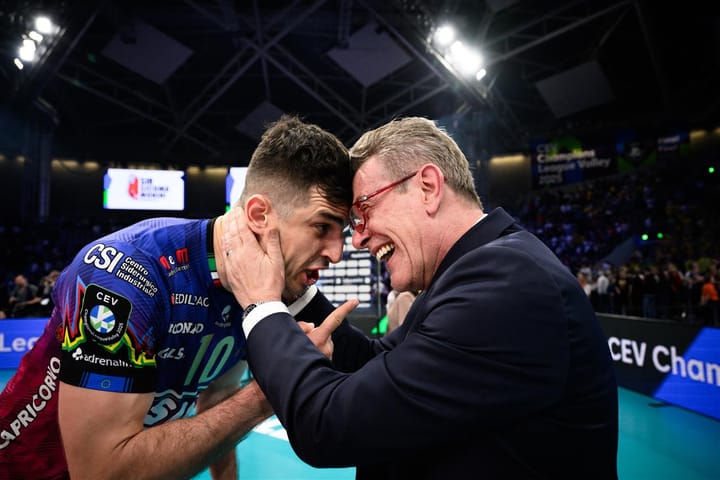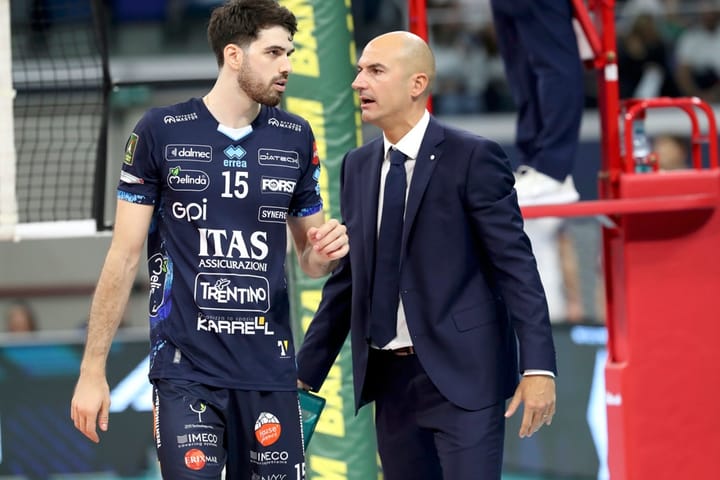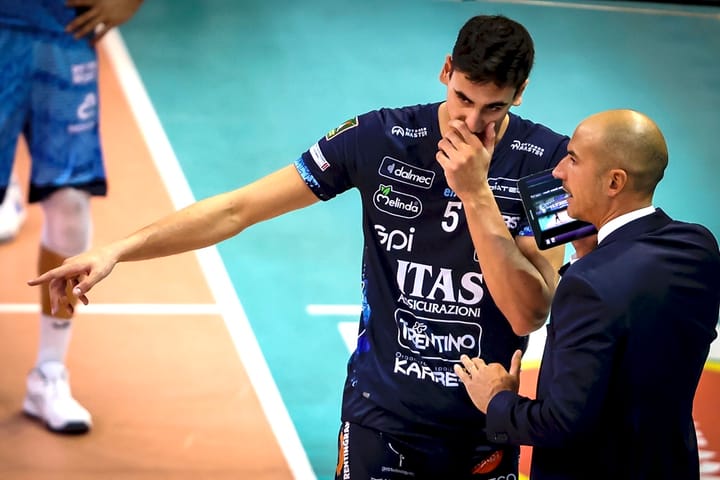25. On the court: The performance tools used by Italian pro teams.
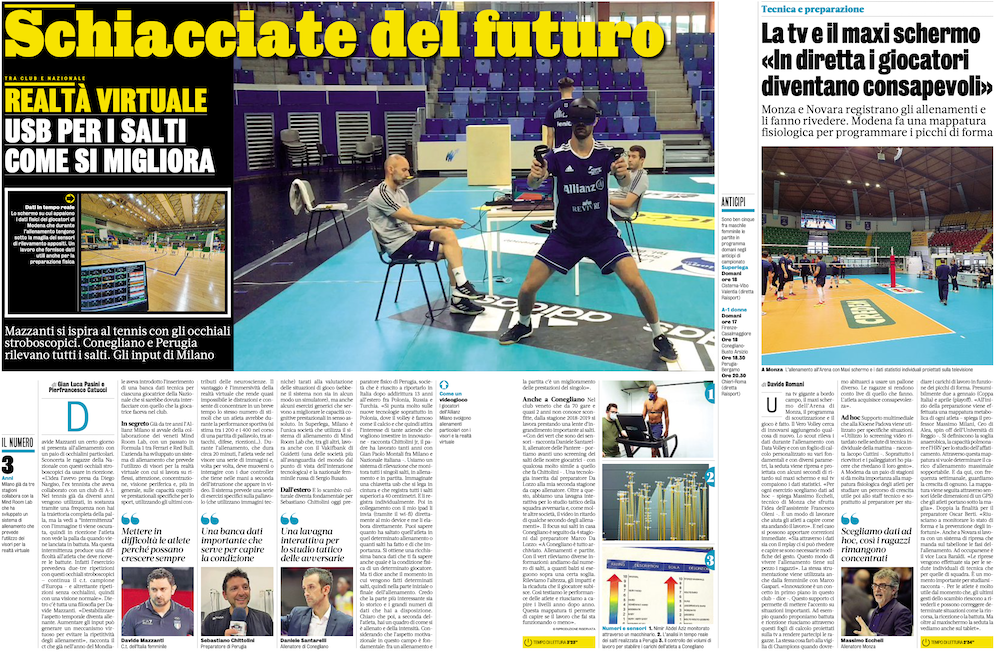
We at volleybrains are fans of staying in our lane, that 'inch wide and mile deep' kind of thing. Don't get distracted, just keep on pumping out interviews with the brightest and best pro volleyball coaches on the globe.😀
BUT! But, once in a while an idea for an article comes along that sticks. This one did. We'll be calling this one and eventual similar posts our 'On the court' articles...
Today we'll cover...
As we are a "coaches' educational platform" (shameless plug = go and signup now!!) everything that has to do with performance, recuperation, training volume and training intensity are topics where we have an interest in.
And that's why volleybrains is sharing this today.
You don't have a limitless budget and you for sure don't need the latest 'training tech' to be a great coach. But we wanted to give extra attention to the importance of measuring and for sure balancing training volume and intensity with athletes of ANY age.
These articles are a little look into the tools that get used by the best teams in the world. But they are for sure mostly tools to improve those last percentiles.
So...together with these "cutting edge performance methods" we also wanted to shine a light on foundational best practices in physical performance for young(er) athletes...
Next 'On the court' article
Well. We sent out 3 questions about physical development in volleyball to 3 top experts in that field.
This Wednesday we'll be launching that article(originally part of this one, but it became too long 🙂).
We'll feature these S&C coaches:
- Vanny Miale: Strength and Conditioning coach of Turkish powerhouse Vakifbank
- Sebastiano Chittolini: Strength and Conditioning coach of the Italian squad of Sir Safety Perugia (Matt Anderson and Leon's current club team)
- Nicola Giolito: Assistant coach of Italian Men's NT team and of Polish club team Jastrebsbi Wegiel (and S&C expert)
Don't miss out. Best way to be reminded is to follow our Instagram page. 👍🏻
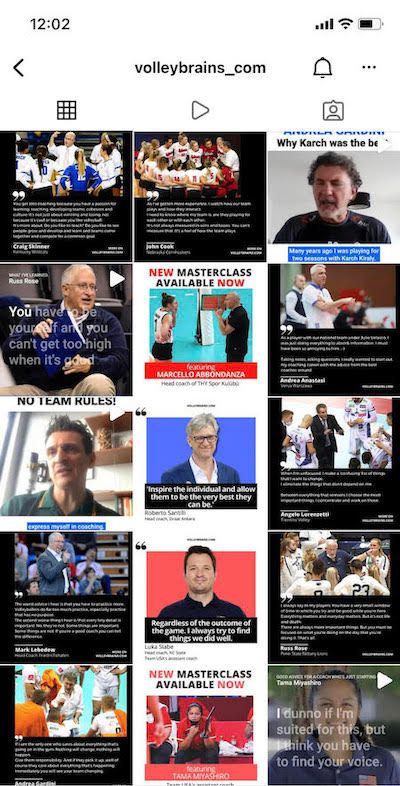
The articles
Thanks to Gian Luca Pasini, Valeria Benedetti, Pierfrancesco Catucci and Davide Romani from Italy's number 1 sports newspaper 'La Gazzetta dello Sport' to enable us to feature these articles.

"Screens, sensors, augmented reality, statistical surveys on everything, from the technical gesture to the physical values, to monitoring the overall health status of the athletes. The frenetic evolution of technology has also changed the face of professional sports.
If thirty years ago statistical surveys of matches seemed an exceptional process, now it's the norm for a Serie A team. The standard scouting reports that get made during the matches are something we've been seeing for over 2 decades. Now we've added new tools to analyse the efficiency and readiness of the athletes and the team itself where the main goal became to keep the athletes' health under control.
An almost daily evolution (which goes hand in hand with the exploration of the potential of innovations) of the tools available to pro teams to get the most out of the team. A trend not only Italian, however: many innovations are used in the national and club teams of other countries also.
We take you on a fascinating journey behind the scenes of pro volleyball"
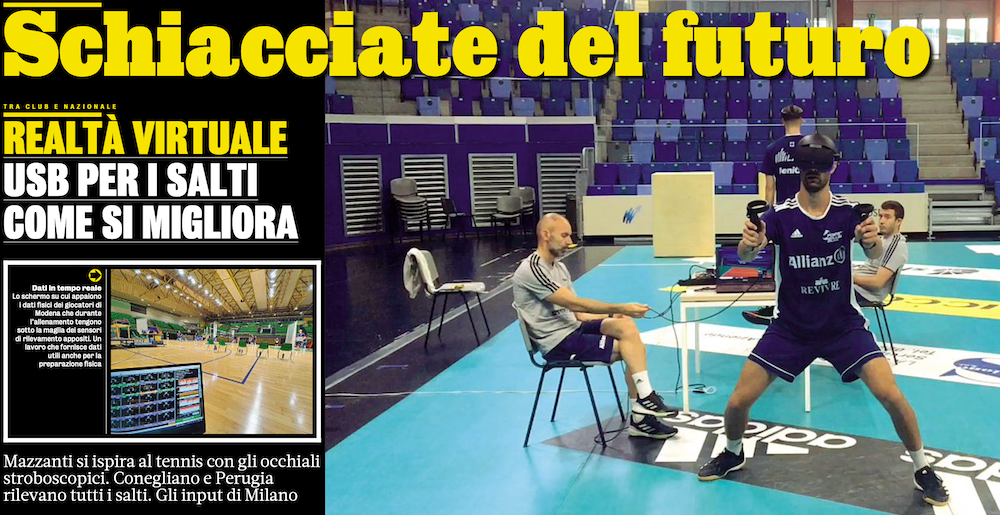
"Davide Mazzanti shows up on training with a special pair of goggles. Surprising the women on the Italian national team with stroboscopic glasses to be used by their receiving players. "I got the idea from Diego Nargiso, a former tennis player who had collaborated with an A-1 Italian club team.
They are being used in tennis for many years. Essentially by means of an electric frequency that goes through the lenses of these glasses they become black and switch back to being transparent with a certain amplitude. While receiving the athlete doesn't see the complete trajectory of the ball, just parts of it.
This intermittence of vision produces a challenge for the athlete. The exercise that we use this for involves three receiving reps with these stroboscopic glasses on and as many repetitions without goggles, so with their normal vision.
The theory behind this is to destabilise the normal hand-eye (hand-brain) coordination. Also while we increase the input with these kind of glasses, we avoid an overload of repetition during training. They are a fun addition to an otherwise not challenging but highly technical exercise.
Davide Mazzanti also has a player database in use for each player of the Itlian women's national team, it's a platform where they input their own data during club season. All this to have extra data points on each player who is part of the Italian national team roster."
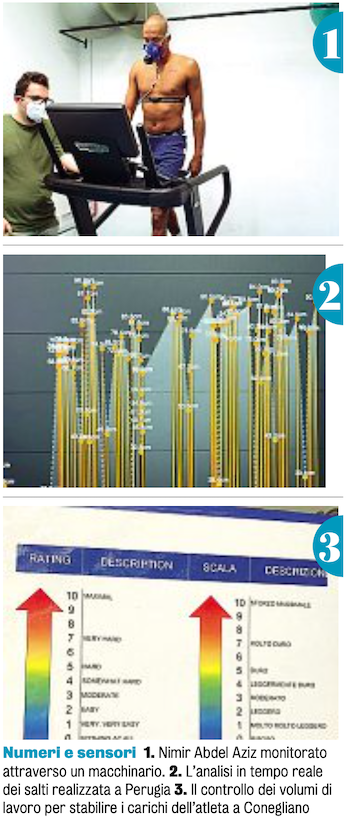
Foto caption. 1. Nimir Abdel Aziz being monitored. 2. Realtime reporting on the amount of jumps being made in Perugia. 3. A report of the player by player overall workload at Conegliano.
"Allianz Milano has been collaborating with the Venetian Mind Room Lab for the last three years. Mind Room Lab has been working together with Formula 1 teams like Ferrari and Red Bull.
The company has developed a training system that involves the use of virtual reality goggles with which you can do different workouts to improve your reflexes, attention, concentration, peripheral vision etc. So more broadly said on cognitive performance specific to sports while using the latest in neuroscientific knowledge.
The advantage here is the total immersion into the virtual reality setup, which makes distractions almost impossible and allows you to perform the same number of stimuli that an athlete would have during a full game (estimated between 200 and 400 reps during a game of volleyball, including attacks, defense, receiving ...)in a shorter time frame.
During the training, which lasts about 20 minutes, the athlete sees a series of images in the viewer and, from time to time, must move or interact with the two controllers he holds in his/her hands according to the instruction that appears on the screen.
The system includes a series of specific volleyball exercises calibrated to actual game situations (although the system is in no way a simulator), but also a fair amount of generic exercises that serve to improve cognitive performance in the absolute sense.
In the Italian Superlega, Allianz Milano is the only club team that uses the Mind Room Lab training system. But it is also used by Guidetti's Vakifbank (btw one of the most advanced club teams when it comes to using tech solutions) and Sergio Busato's Russian women's national team."
"These technological use cases don't only get used in Italy. Sebastiano Chittolini, today a physical coach for the SuperLega team of Perugia, coached club teams in Poland, Russia and Turkey for a period of 13 years.
«There is a lot of focus on new technologies especially in Poland, where volleyball is as famous as soccer and therefore attracts the interest of many companies that want to invest in innovation and bring products to market.
We use a detection system that monitors every individual jump, in training and during the matches. Imagine it being a USB stick that ties into your belt and records every jump higher than 40 centimeters(approx 15 inches) of height. And records them individually. Then in connection with my iPad it processes everything for me in realtime.
You can find out how much the athlete jumped in that particular workout, the load, the average height etc. You get a very rich database that also lets you know what the physical condition of a particular player is. But it also tells you when certain jumps were made, in the initial, middle or final part of the training.
I think the most interesting part is the backlog and the large amounts of data you have at your disposal. Of course the motivational aspect here is also fundamental: between our training and the match there is a clear improvement in the performance of the individual."

"The Venetian club which recently set the World Record of most consecutive wins in a row by a pro volleyball team(74!!) has been tracking the jumps of it's athletes since the 2018-2019 season. Head coach of Conegliano Daniele Santarelli uses a technology very similar to the one used by Chittolini at Perugia.
A technology introduced by trainer Da Lozzo in Santarelli's second season as head coach. In addition to this, they have an interactive whiteboard for their tactical study of the opponent and like many other clubs, an 'always on' video screen during their training seasons with a delay of a few seconds.
Marco Da Lozzo: «In Conegliano everything is archived. Training and matches. With the Vert we detect various information: we go from the number of jumps, to how many jumps are performed above a certain threshold. We measure the height, the impact the player suffers upon landing. We continuously test the performance of our athletes and we are able to understand their individual level year after year. This mapping allows you to understand if the work you do has the required effect or not."
The big screen
"Players immediately become aware of their actions"

"A giant TV on the sidelines, the big screen of the Monza Arena and a scouting program, these are the 3 tools that we use every day. Vero Volley Monza tries to innovate by adding something new. Our scouter does the input for the data during training with Data Volley and uses a personalized spreadsheet on various fundamentals and with different parameters, the training session is projected with a few seconds of delay on the big screen and the statistical data appears on the TV.
"For each exercise we choose ad hoc data - explains Massimo Eccheli, head coach of Monza who implemented the idea of his assistant coach Francesco Oleni -. It helps athletes understand how work is going». We are able to make immediate corrections. «Both through the data and with the replay it is possible to review and understand if changes are necessary. This way of live feedback training keeps the boys on track."
The same tools are also used by the women's team with Marco Gaspari. «Innovation is at the foreground in this club - he says -. These tools allow us to emphasize important situations. For example, when we practice our serve-receive we are able to offer a complementary degree of data through these spreadsheets projected on the TV, we feel that our players are more engaged in practice having these tools at our disposal.
With the Champions League that will start in a short period from now also comes the use of a different type of ball for us. With the use of our tools we can actually see the difference that makes and if the numbers tell us to get an extra training in to further adapt or not. The girls realize what they are doing at every moment of the way. The athlete gains awareness."
Multimedia support is also used for specific situations at Kioene Padova. «I use delayed video screening in our individual technical sessions in the mornings - says Jacopo Cuttini -. Especially the receivers and setters review their technical gestures».
In Modena, since a couple of seasons, great importance has been given to the physiological mapping of athletes to study their physiological growth path that is then useful to the technical staff and above all to the Strength and Conditioning coach to study the workloads according to the performance peaks the team is aiming for.
These peaks are presumably, one in January (Coppa Italia) and the other one in April (playoffs). "At the beginning of the preparation, a metabolic mapping of each athlete is carried out - explains professor Massimo Milani, CEO of Alea, spin off of the University of Reggio -. The anaerobic threshold, lung capacity and HRV are defined to study the fatigue threshold of the individual athlete.
Through this mapping we want to determine the maximum tolerable training load. And from there, on a weekly basis, we check the evolution of the individual athlete. The mapping is enabled through sensors that the athletes wear under their shirts».
There is a twofold advantage says trainer Oscar Berti. "We are able to monitor the current state of the athlete at all times and while having their workload in check we can prevent overuse injuries to a great extent."
Also in Novara they work with a review system that sends the training phases onto a video screen. Assistant coach Luca Baraldi takes care of this. «Filming is done both for individual technical sessions and for team sessions. It is an important time to study - he says -. For athletes it is very useful, they can correct certain situations such as their own movement on court, in receiving or in serving. In addition to the big screen, we can also see the session on the tablet "
Stay put for next Wednesday's article with 3 top volleyball S&C experts.
